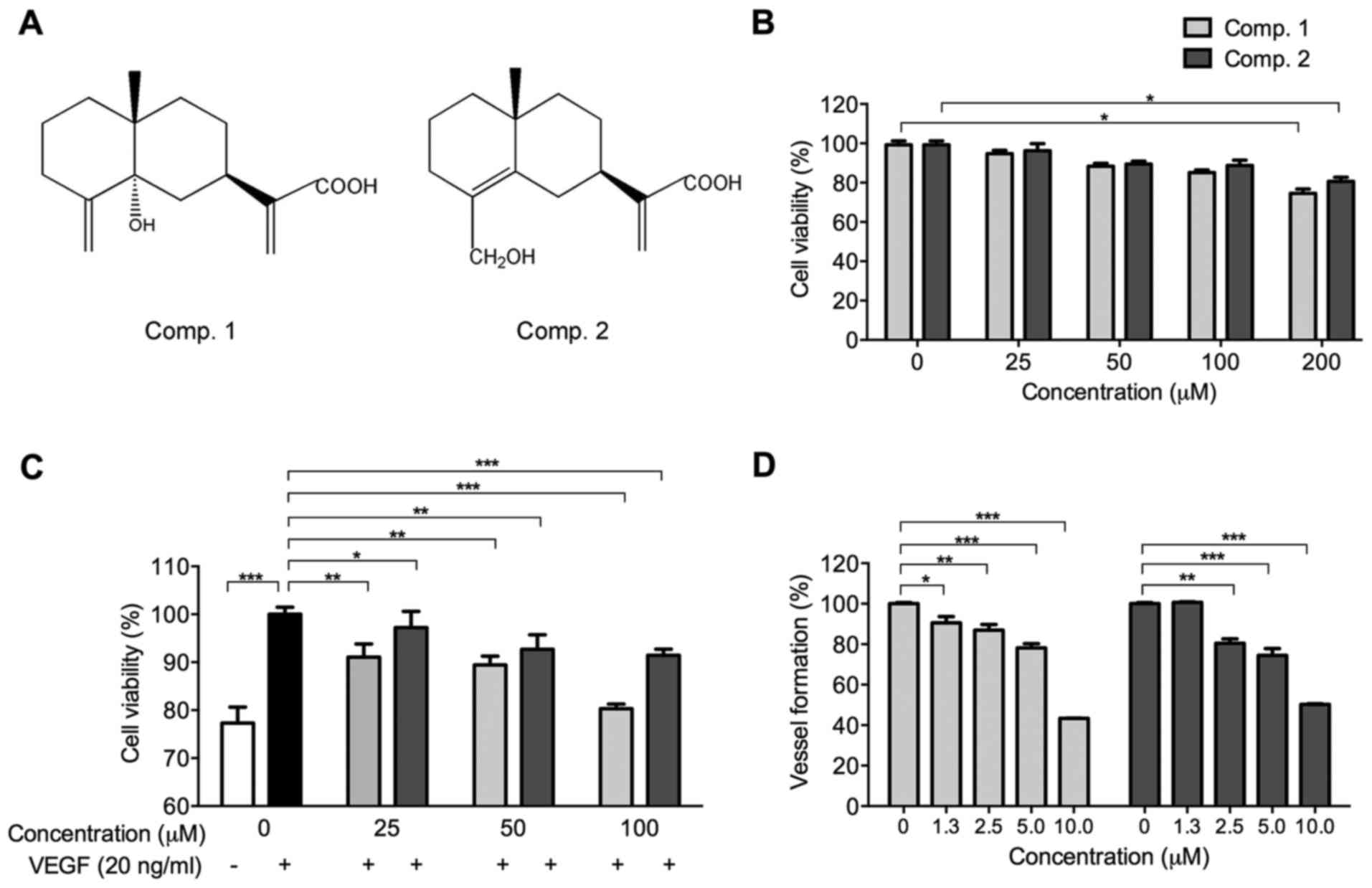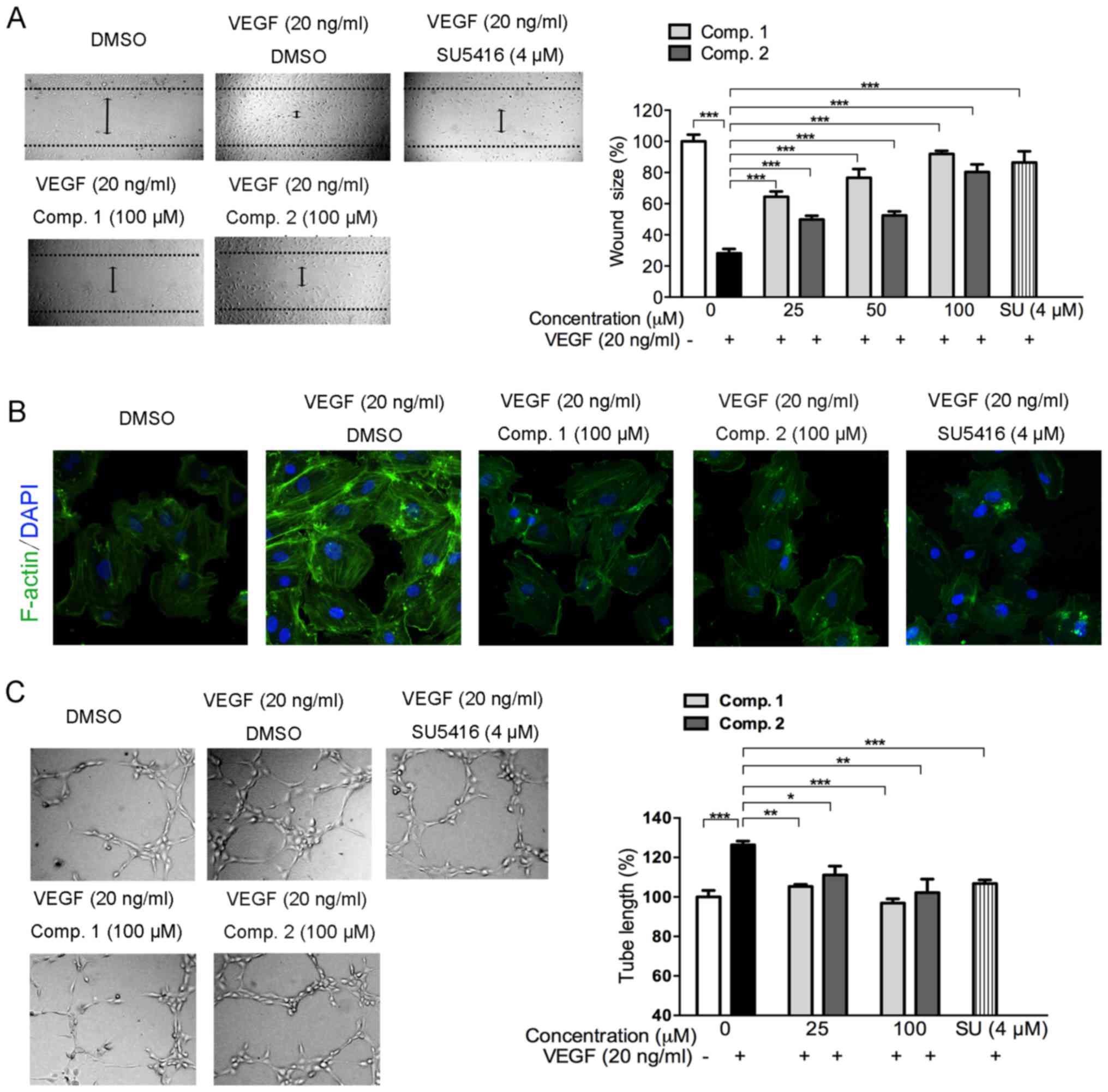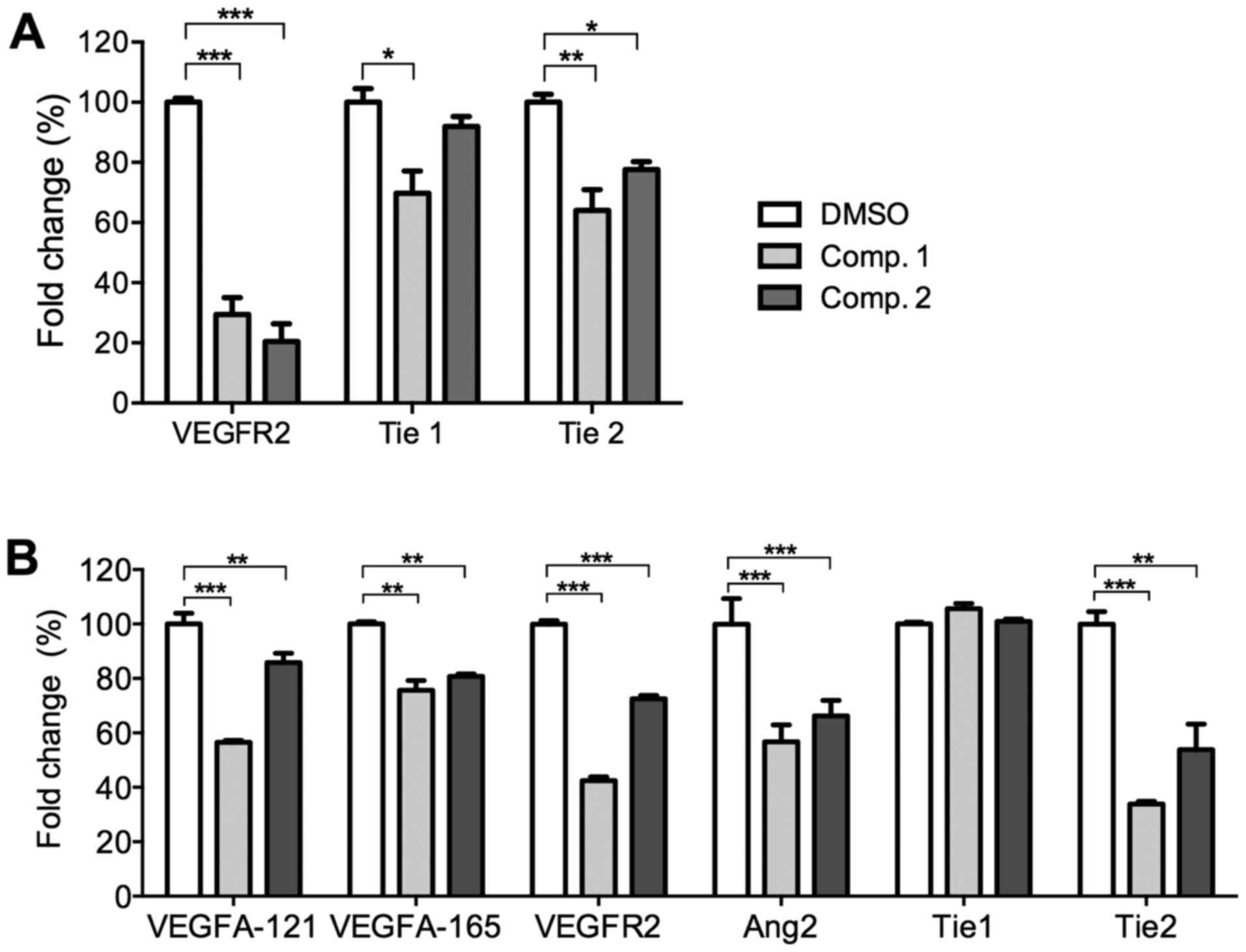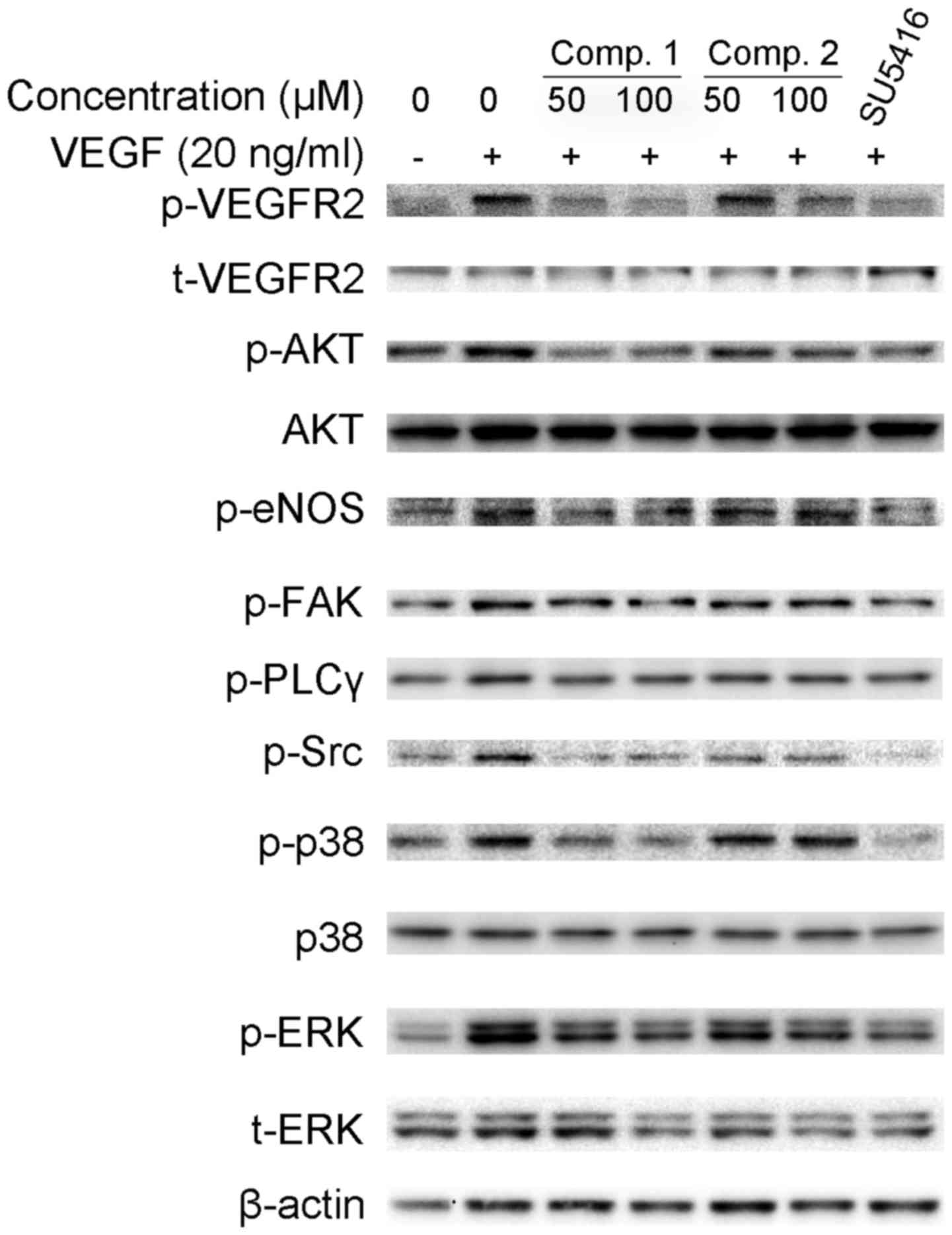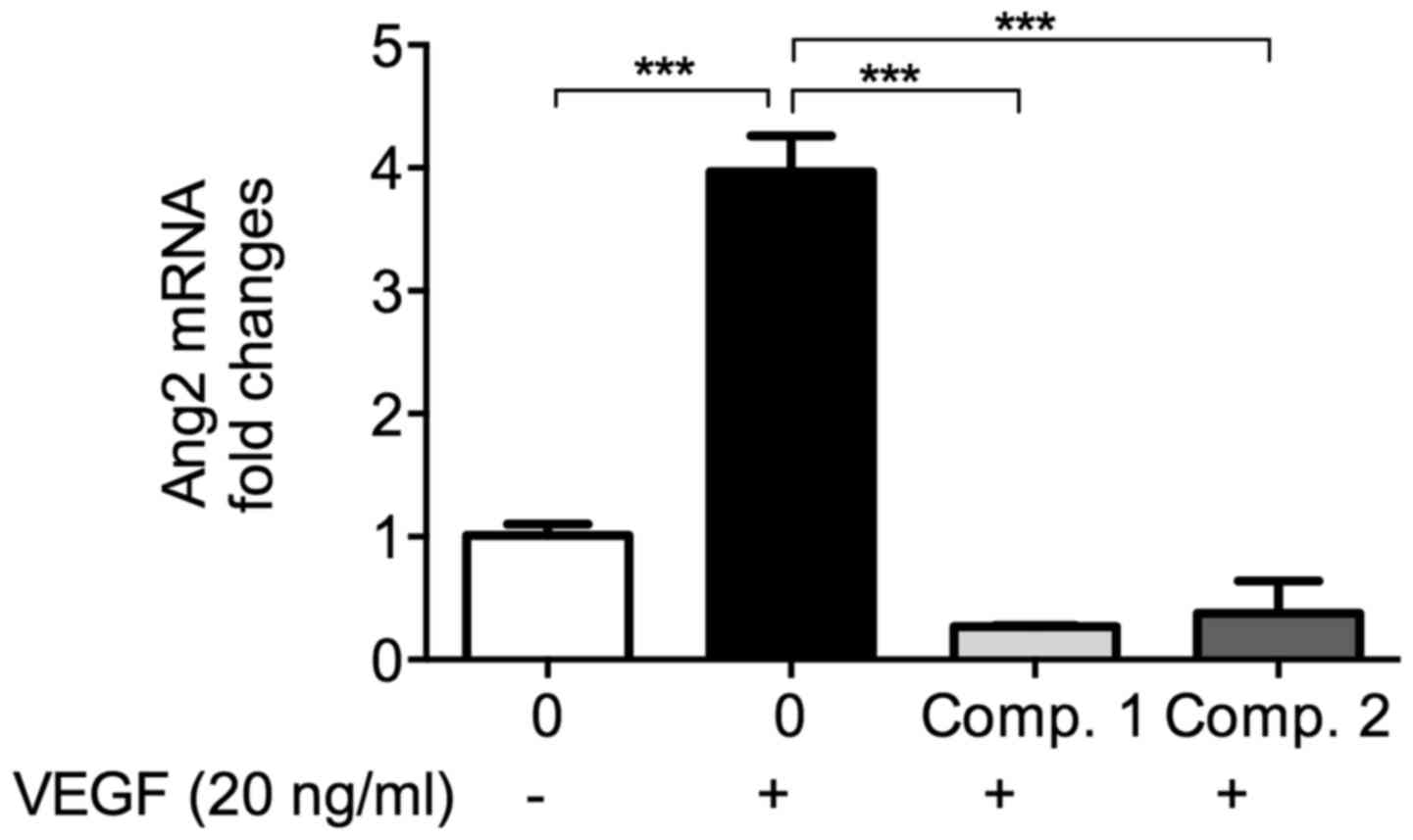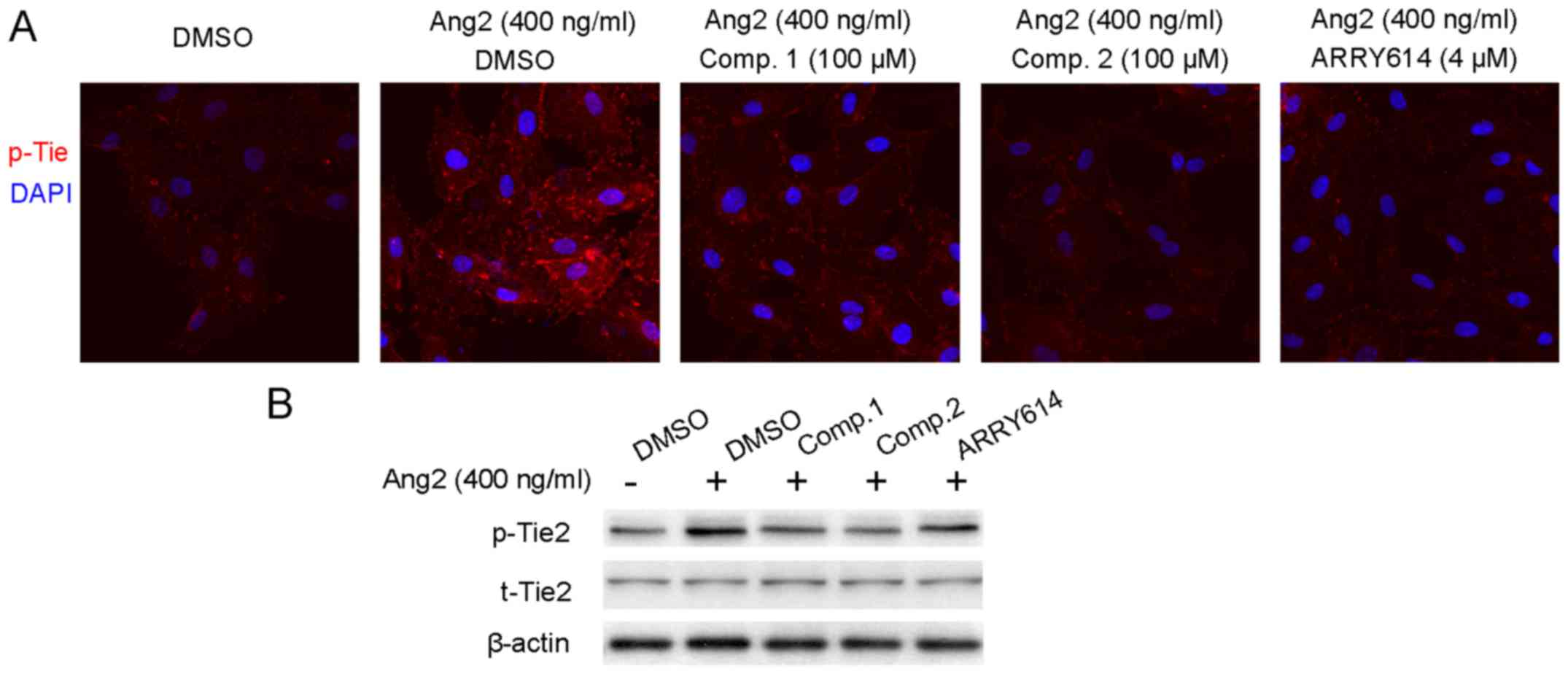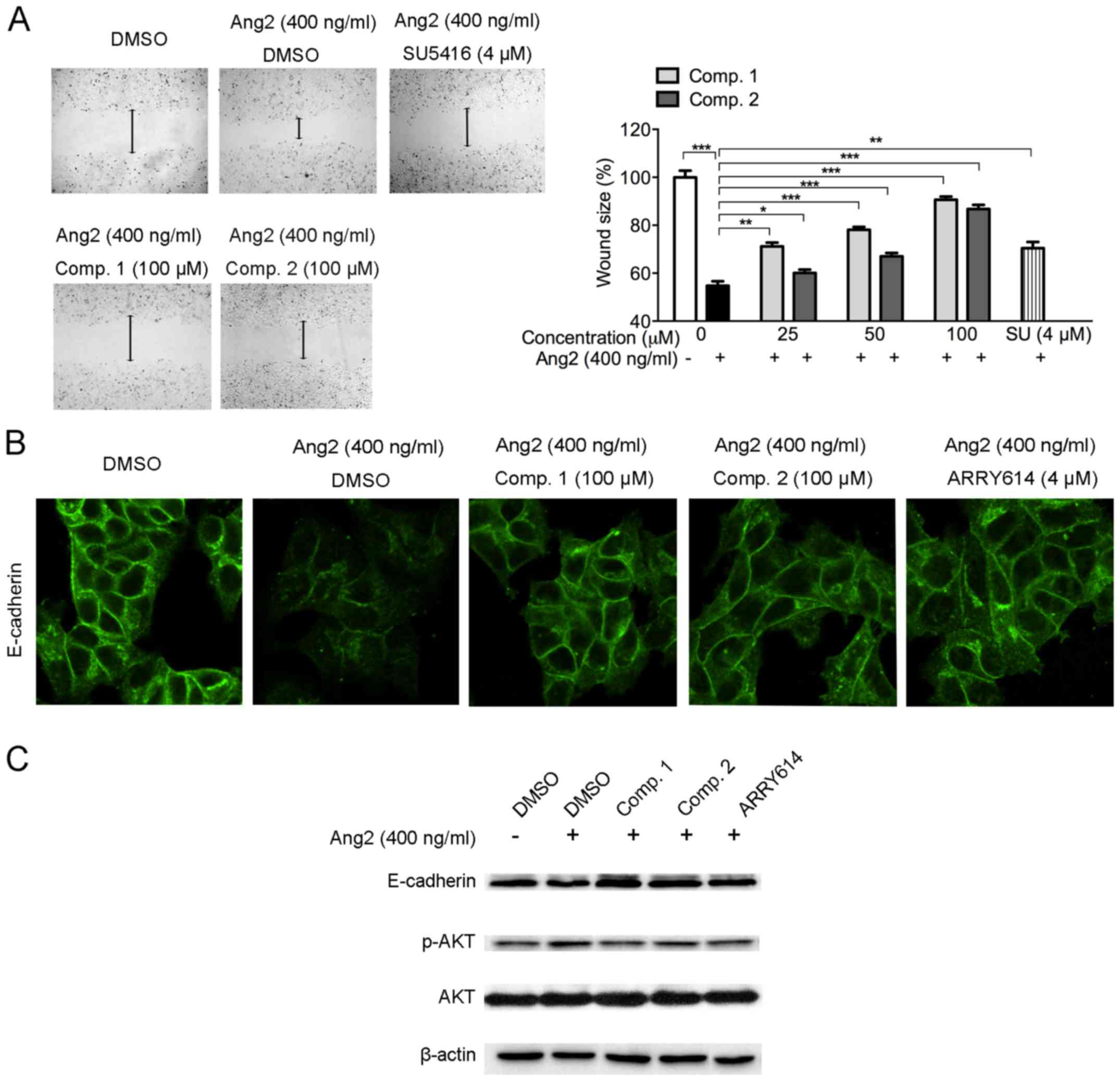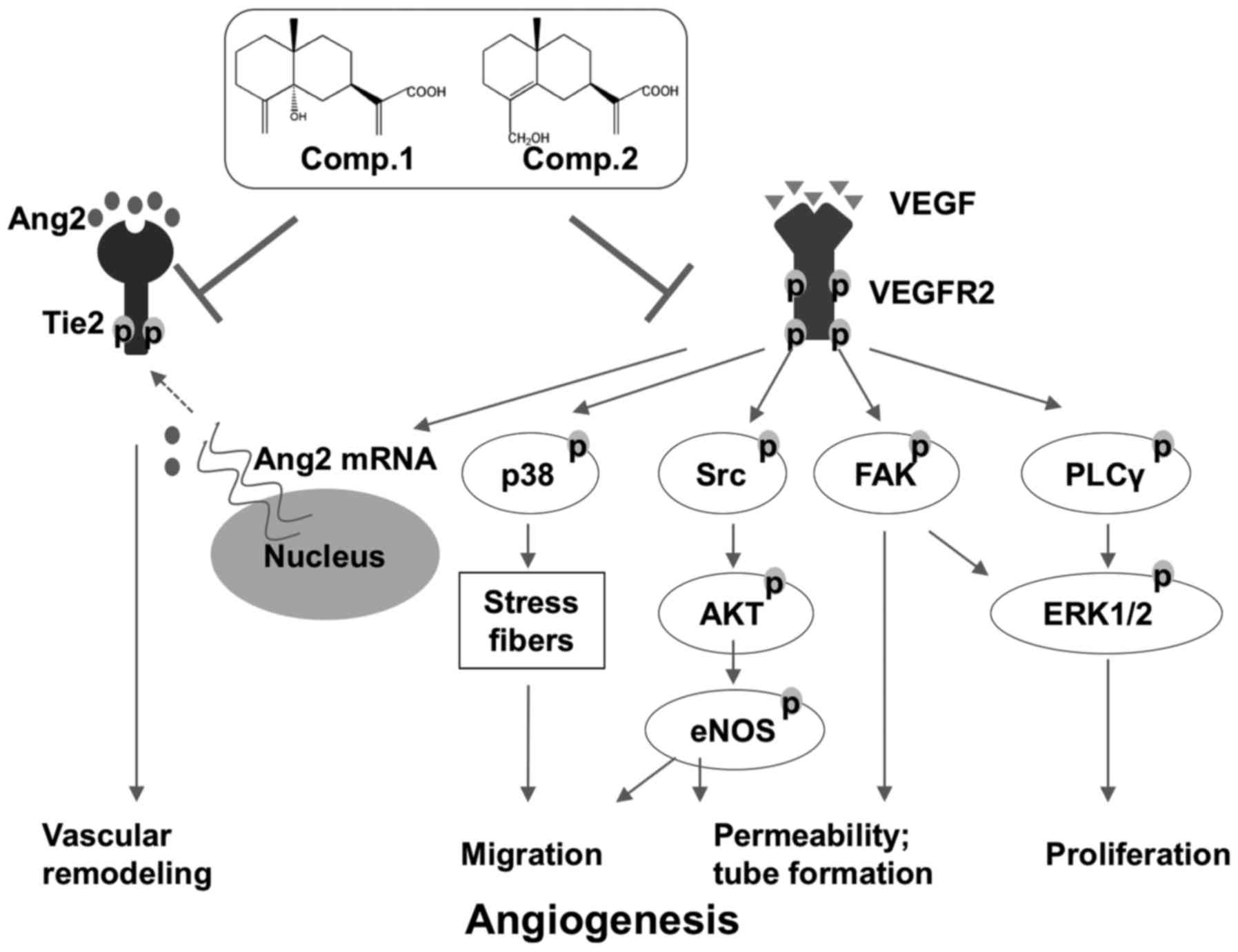|
1
|
Folkman J: Fighting cancer by attacking
its blood supply. Sci Am. 275:150–154. 1996. View Article : Google Scholar : PubMed/NCBI
|
|
2
|
Folkman J: Angiogenesis. Annu Rev Med.
57:1–18. 2006. View Article : Google Scholar : PubMed/NCBI
|
|
3
|
Ferrara N and Kerbel RS: Angiogenesis as a
therapeutic target. Nature. 438:967–974. 2005. View Article : Google Scholar : PubMed/NCBI
|
|
4
|
Herbert SP and Stainier DY: Molecular
control of endothelial cell behaviour during blood vessel
morphogenesis. Nat Rev Mol Cell Biol. 12:551–564. 2011. View Article : Google Scholar : PubMed/NCBI
|
|
5
|
Taimeh Z, Loughran J, Birks EJ and Bolli
R: Vascular endothelial growth factor in heart failure. Nat Rev
Cardiol. 10:519–530. 2013. View Article : Google Scholar : PubMed/NCBI
|
|
6
|
Jayson GC, Kerbel R, Ellis LM and Harris
AL: Antiangiogenic therapy in oncology: Current status and future
directions. Lancet. 388:518–529. 2016. View Article : Google Scholar : PubMed/NCBI
|
|
7
|
Carmeliet P and Jain RK: Molecular
mechanisms and clinical applications of angiogenesis. Nature.
473:298–307. 2011. View Article : Google Scholar : PubMed/NCBI
|
|
8
|
Biel NM and Siemann DW: Targeting the
angiopoietin-2/Tie-2 axis in conjunction with VEGF signal
interference. Cancer Lett. 380:525–533. 2016. View Article : Google Scholar
|
|
9
|
Augustin HG, Koh GY, Thurston G and
Alitalo K: Control of vascular morphogenesis and homeostasis
through the angiopoietin-Tie system. Nat Rev Mol Cell Biol.
10:165–177. 2009. View Article : Google Scholar : PubMed/NCBI
|
|
10
|
Fagiani E and Christofori G: Angiopoietins
in angiogenesis. Cancer Lett. 328:18–26. 2013. View Article : Google Scholar
|
|
11
|
Gerald D, Chintharlapalli S, Augustin HG
and Benjamin LE: Angiopoietin-2: An attractive target for improved
antiangiogenic tumor therapy. Cancer Res. 73:1649–1657. 2013.
View Article : Google Scholar : PubMed/NCBI
|
|
12
|
Rigamonti N, Kadioglu E, Keklikoglou I,
Wyser Rmili C, Leow CC and De Palma M: Role of angiopoietin-2 in
adaptive tumor resistance to VEGF signaling blockade. Cell Rep.
8:696–706. 2014. View Article : Google Scholar : PubMed/NCBI
|
|
13
|
Kienast Y, Klein C, Scheuer W, Raemsch R,
Lorenzon E, Bernicke D, Herting F, Yu S, The HH, Martarello L, et
al: Ang-2-VEGF-A CrossMab, a novel bispecific human IgG1 antibody
blocking VEGF-A and Ang-2 functions simultaneously, mediates potent
antitumor, antiangiogenic, and antimetastatic efficacy. Clin Cancer
Res. 19:6730–6740. 2013. View Article : Google Scholar : PubMed/NCBI
|
|
14
|
Wu YH, Zhang XM, Hu MH, Wu XM and Zhao Y:
Effect of Laggera alata on hepatocyte damage induced by carbon
tetrachloride in vitro and in vivo. J Ethnopharmacol. 126:50–56.
2009. View Article : Google Scholar : PubMed/NCBI
|
|
15
|
Wu Y, Zhou C, Song L, Li X, Shi S, Mo J,
Chen H, Bai H, Wu X, Zhao J, et al: Effect of total phenolics from
Laggera alata on acute and chronic inflammation models. J
Ethnopharmacol. 108:243–250. 2006. View Article : Google Scholar : PubMed/NCBI
|
|
16
|
Wang GC, Li GQ, Geng HW, Li T, Xu JJ, Ma
F, Wu X, Ye WC and Li YL: Eudesmane-type sesquiterpene derivatives
from Laggera alata. Phytochemistry. 96:201–207. 2013. View Article : Google Scholar : PubMed/NCBI
|
|
17
|
Pratheeshkumar P, Budhraja A, Son YO, Wang
X, Zhang Z, Ding S, Wang L, Hitron A, Lee JC, Xu M, et al:
Quercetin inhibits angiogenesis mediated human prostate tumor
growth by targeting VEGFR- 2 regulated AKT/mTOR/P70S6K signaling
pathways. PLoS One. 7:e475162012. View Article : Google Scholar : PubMed/NCBI
|
|
18
|
Huang W, Wang J, Liang Y, Ge W, Wang G, Li
Y and Chung HY: Potent anti-angiogenic component in Croton
crassifolius and its mechanism of action. J Ethnopharmacol.
175:185–191. 2015. View Article : Google Scholar : PubMed/NCBI
|
|
19
|
Li M, Wu S, Liu Z, Zhang W, Xu J, Wang Y,
Liu J, Zhang D, Tian H, Li Y, et al: Arenobufagin, a bufadienolide
compound from toad venom, inhibits VEGF-mediated angiogenesis
through suppression of VEGFR-2 signaling pathway. Biochem
Pharmacol. 83:1251–1260. 2012. View Article : Google Scholar : PubMed/NCBI
|
|
20
|
Lin S, Ching LT, Chen J and Cheung PCK:
Antioxidant and anti-angiogenic effects of mushroom phenolics-rich
fractions. J Funct Foods. 17:802–815. 2015. View Article : Google Scholar
|
|
21
|
Li H, Li M, Wang G, Shao F, Chen W, Xia C,
Wang S, Li Y, Zhou G and Liu Z: EM23, A natural sesquiterpene
lactone from Elephantopus mollis, induces apoptosis in human
myeloid leukemia cells through thioredoxin- and reactive oxygen
species-mediated signaling pathways. Front Pharmacol. 7:772016.
View Article : Google Scholar : PubMed/NCBI
|
|
22
|
Bogdanovic E, Nguyen VP and Dumont DJ:
Activation of Tie2 by angiopoietin-1 and angiopoietin-2 results in
their release and receptor internalization. J Cell Sci.
119:3551–3560. 2006. View Article : Google Scholar : PubMed/NCBI
|
|
23
|
Robert S and Kerbel PD: Tumor
angiogenesis. N Engl J Med. 358:2039–2049. 2008. View Article : Google Scholar
|
|
24
|
Rousseau S, Houle F, Kotanides H, Witte L,
Waltenberger J, Landry J and Huot J: Vascular endothelial growth
factor (VEGF)-driven actin-based motility is mediated by VEGFR2 and
requires concerted activation of stress-activated protein kinase 2
(SAPK2/p38) and geldanamycin-sensitive phosphorylation of focal
adhesion kinase. J Biol Chem. 275:10661–10672. 2000. View Article : Google Scholar : PubMed/NCBI
|
|
25
|
Shibuya M: VEGF-VEGFR signals in health
and disease. Biomol Ther (Seoul). 22:1–9. 2014. View Article : Google Scholar
|
|
26
|
Ha CH, Bennett AM and Jin ZG: A novel role
of vascular endothelial cadherin in modulating c-Src activation and
downstream signaling of vascular endothelial growth factor. J Biol
Chem. 283:7261–7270. 2008. View Article : Google Scholar : PubMed/NCBI
|
|
27
|
Eroglu Z, Stein CA and Pal SK: Targeting
angiopoietin-2 signaling in cancer therapy. Expert Opin Investig
Drugs. 22:813–825. 2013. View Article : Google Scholar : PubMed/NCBI
|
|
28
|
Onder TT, Gupta PB, Mani SA, Yang J,
Lander ES and Weinberg RA: Loss of E-cadherin promotes metastasis
via multiple downstream transcriptional pathways. Cancer Res.
68:3645–3654. 2008. View Article : Google Scholar : PubMed/NCBI
|
|
29
|
Hanahan D and Weinberg RA: Hallmarks of
cancer: The next generation. Cell. 144:646–674. 2011. View Article : Google Scholar : PubMed/NCBI
|
|
30
|
Wahl O, Oswald M, Tretzel L, Herres E,
Arend J and Efferth T: Inhibition of tumor angiogenesis by
antibodies, synthetic small molecules and natural products. Curr
Med Chem. 18:3136–3155. 2011. View Article : Google Scholar : PubMed/NCBI
|
|
31
|
Chen X, Zhao M, Hao M, Sun X, Wang J, Mao
Y, Zu L, Liu J, Shen Y, Wang J, et al: Dual inhibition of PI3K and
mTOR mitigates compensatory AKT activation and improves tamoxifen
response in breast cancer. Mol Cancer Res. 11:1269–1278. 2013.
View Article : Google Scholar : PubMed/NCBI
|
|
32
|
Ying L and Hofseth LJ: An emerging role
for endothelial nitric oxide synthase in chronic inflammation and
cancer. Cancer Res. 67:1407–1410. 2007. View Article : Google Scholar : PubMed/NCBI
|
|
33
|
Lim KH, Ancrile BB, Kashatus DF and
Counter CM: Tumour maintenance is mediated by eNOS. Nature.
452:646–649. 2008. View Article : Google Scholar : PubMed/NCBI
|
|
34
|
Di Lorenzo A, Lin MI, Murata T,
Landskroner-Eiger S, Schleicher M, Kothiya M, Iwakiri Y, Yu J,
Huang PL and Sessa WC: eNOS-derived nitric oxide regulates
endothelial barrier function through VE-cadherin and Rho GTPases. J
Cell Sci. 126:5541–5552. 2013. View Article : Google Scholar : PubMed/NCBI
|
|
35
|
Sulzmaier FJ, Jean C and Schlaepfer DD:
FAK in cancer: Mechanistic findings and clinical applications. Nat
Rev Cancer. 14:598–610. 2014. View Article : Google Scholar : PubMed/NCBI
|
|
36
|
Wu G, Luo J, Rana JS, Laham R, Sellke FW
and Li J: Involvement of COX-2 in VEGF-induced angiogenesis via P38
and JNK pathways in vascular endothelial cells. Cardiovasc Res.
69:512–519. 2006. View Article : Google Scholar
|
|
37
|
Chen XL, Nam JO, Jean C, Lawson C, Walsh
CT, Goka E, Lim ST, Tomar A, Tancioni I, Uryu S, et al:
VEGF-induced vascular permeability is mediated by FAK. Dev Cell.
22:146–157. 2012. View Article : Google Scholar : PubMed/NCBI
|
|
38
|
Mariappan MM, Senthil D, Natarajan KS,
Choudhury GG and Kasinath BS: Phospholipase Cgamma-Erk Axis in
vascular endothelial growth factor-induced eukaryotic initiation
factor 4E phosphorylation and protein synthesis in renal epithelial
cells. J Biol Chem. 280:28402–28411. 2005. View Article : Google Scholar : PubMed/NCBI
|
|
39
|
Shojaei F: Anti-angiogenesis therapy in
cancer: Current challenges and future perspectives. Cancer Lett.
320:130–137. 2012. View Article : Google Scholar : PubMed/NCBI
|
|
40
|
Moss A: The angiopoietin:Tie 2
interaction: a potential target for future therapies in human
vascular disease. Cytokine Growth Factor Rev. 24:579–592. 2013.
View Article : Google Scholar : PubMed/NCBI
|
|
41
|
Scholz A, Plate KH and Reiss Y:
Angiopoietin-2: A multifaceted cytokine that functions in both
angiogenesis and inflammation. Ann NY Acad Sci. 1347:45–51. 2015.
View Article : Google Scholar : PubMed/NCBI
|
|
42
|
Yuan HT, Khankin EV, Karumanchi SA and
Parikh SM: Angiopoietin 2 is a partial agonist/antagonist of Tie2
signaling in the endothelium. Mol Cell Biol. 29:2011–2022. 2009.
View Article : Google Scholar : PubMed/NCBI
|
|
43
|
Cascone T and Heymach JV: Targeting the
angiopoietin/Tie2 pathway: Cutting tumor vessels with a
double-edged sword? J Clin Oncol. 30:441–444. 2012. View Article : Google Scholar
|
|
44
|
Serbedzija GN, Flynn E and Willett CE:
Zebrafish angiogenesis: A new model for drug screening.
Angiogenesis. 3:353–359. 1999. View Article : Google Scholar
|
|
45
|
Tobia C, Gariano G, De Sena G and Presta
M: Zebrafish embryo as a tool to study tumor/endothelial cell
cross-talk. Biochim Biophys Acta. 1832:1371–1377. 2013. View Article : Google Scholar : PubMed/NCBI
|















